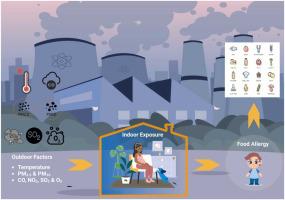当前位置:
X-MOL 学术
›
J. Hazard. Mater.
›
论文详情
Our official English website, www.x-mol.net, welcomes your feedback! (Note: you will need to create a separate account there.)
Children's food allergy: Effects of environmental influences and antibiotic use across critical developmental windows
Journal of Hazardous Materials ( IF 13.6 ) Pub Date : 2024-05-06 , DOI: 10.1016/j.jhazmat.2024.134506 Chan Lu , Ying Jiang , Mengju Lan , Lin Wang , Wanzhen Zhang , Faming Wang
Journal of Hazardous Materials ( IF 13.6 ) Pub Date : 2024-05-06 , DOI: 10.1016/j.jhazmat.2024.134506 Chan Lu , Ying Jiang , Mengju Lan , Lin Wang , Wanzhen Zhang , Faming Wang

|
Increasing studies linked outdoor air pollution (OAP), indoor environmental factors (IEFs), and antibiotics use (AU) with the first wave of allergies (i.e., asthma, allergic rhinitis, and eczema), yet the role of their exposures on children’s second wave of allergy (i.e., food allergy) are unknown. To investigate the association between exposure to OAP and IEFs and childhood doctor-diagnosed food allergy (DFA) during the pre-pregnancy, prenatal, early postnatal, and current periods, and to further explore the effect of OAP and IEFs on DFA in children co-exposed to antibiotics. A retrospective cohort study involving 8689 preschoolers was carried out in Changsha, China. Data on the health outcomes, antibiotic use, and home environment of each child were collected through a questionnaire. Temperature and air pollutants data were obtained from 8 and 10 monitoring stations in Changsha, respectively. Exposure levels to temperature and air pollutants at individual home addresses were calculated by the inverse distance weighted (IDW) method. Multiple logistic regression models were employed to assess the associations of childhood DFA with exposure to OAP, IEF, and AU. Childhood ever doctor-diagnosed food allergy (DFA) was linked to postnatal PM exposure with OR (95% CI) of 1.18 (1.03–1.36), especially for CO and O exposure during the first year with ORs (95% CI) = 1.08 (1.00–1.16) and 1.07 (1.00–1.14), as well as SO exposure during the previous year with OR (95% CI) of 1.13 (1.02–1.25). The role of postnatal air pollution is more important for the risk of egg, milk and other food allergies. Renovation-related IAP (new furniture) and dampness-related indoor allergens exposures throughout all time windows significantly increased the risk of childhood DFA, with ORs ranging from 1.23 (1.03–1.46) to 1.54 (1.29–1.83). Furthermore, smoke-related IAP (environmental tobacco smoke [ETS], parental and grandparental smoking) exposure during pregnancy, first year, and previous year was related to DFA. Additionally, exposure to pet-related indoor allergens (cats) during first year and total plant-related allergens (particularly nonflowering plants) during previous year were associated with DFA. Moreover, exposure to plant-related allergy during first and previous year was specifically associated with milk allergy, while keeping cats during first year increased the risk of fruits/vegetables allergy. Life-time and early-life AU was associated with the increased risk of childhood DFA with ORs (95% CI) = 1.57 (1.32–1.87) and 1.46 (1.27–1.67), including different types food allergies except fruit/vegetable allergy. Postnatal OAP, life-time and early-life IEFs and AU exposure played a vital role in the development of DFA, supporting the "fetal origin of childhood FA" hypothesis.
更新日期:2024-05-06






























 京公网安备 11010802027423号
京公网安备 11010802027423号